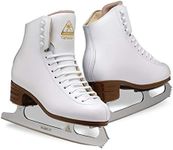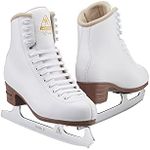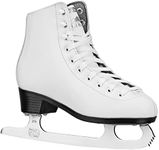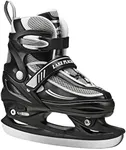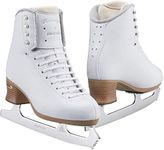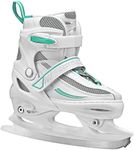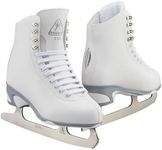Buying Guide for the Best Kids Figure Skates
Choosing the right pair of figure skates for your child is crucial for their comfort, safety, and performance on the ice. It's important to consider several key specifications to ensure that the skates you select are the best fit for your child's needs and skill level. Here are the key specs to look out for and how to navigate them.Size and FitThe size and fit of figure skates are critical because they directly affect your child's comfort and ability to skate properly. Skates that are too tight can cause pain and restrict movement, while skates that are too loose can lead to instability and increase the risk of injury. To find the right size, measure your child's foot and compare it to the skate manufacturer's sizing chart. Ensure there is a snug fit around the heel and ankle, with enough room to wiggle the toes slightly. It's also a good idea to try on skates with the same type of socks your child will wear while skating.
Boot SupportBoot support refers to the stiffness and structure of the skate boot, which is important for providing the necessary ankle support and stability. For beginners, softer boots are recommended as they are more comfortable and easier to break in. As your child progresses and starts performing more advanced maneuvers, stiffer boots will be needed to provide the necessary support for jumps and spins. Assess your child's current skill level and choose the boot support accordingly.
Blade QualityThe quality of the blade is essential for good performance on the ice. Blades are typically made of stainless steel and can vary in terms of sharpness and durability. For beginners, standard blades that come with most skates are usually sufficient. However, as your child advances, you may want to consider higher-quality blades that offer better edge retention and precision. Regularly check and maintain the sharpness of the blades to ensure optimal performance.
Lacing SystemThe lacing system of figure skates affects how securely the skates fit and how easily they can be put on and taken off. Traditional laces offer the most customizable fit, allowing you to adjust the tightness at different points of the boot. Some modern skates come with quick-lace systems or Velcro straps, which can be more convenient for younger children. Consider your child's ability to lace up their skates and choose a system that balances convenience with a secure fit.
Comfort and PaddingComfort and padding inside the skate boot are important for preventing blisters and ensuring a pleasant skating experience. Look for skates with adequate padding around the ankles and tongue, as well as a comfortable insole. The level of padding can vary, so it's important to try on different skates to see which ones feel the best for your child. Remember that comfort can significantly impact your child's enjoyment and willingness to skate.
DurabilityDurability is a key factor, especially if your child skates frequently or is involved in competitive skating. Durable skates are made from high-quality materials that can withstand the wear and tear of regular use. Check for reinforced areas, such as the toe box and heel, which are prone to damage. Investing in durable skates can save you money in the long run and ensure your child has reliable equipment.


